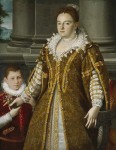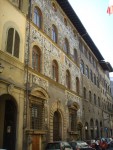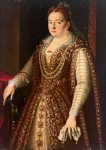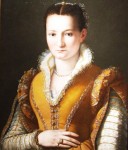- Portrait of Grand Duchess Bianca Capello de Medici, by Allori
- Palazzo di Bianca Capello in Florence
- Bianca Capello by Alessandro Allori
- Bianca Capello, by Alessandro Allori (1535-1607)
By Lindsay Smith, Troy O’Neill, and Piera Carroli
Bianca Capello (c. 1548-87) was born to Pellegrina Morosini and Bartolomeo Capello, who were members of the wealthy Capelli nobility in Venice, Italy.[1] Not much is known about her childhood, but by the time she reached adolescence, she was known for her great beauty, with reddish blond hair and a voluptuous figure.[2]
At the age of fifteen, Capello scandalized her family by secretly marrying Florentine Pietro Buonaventura in c.1563 .[3] Maria Donati, the Capello family’s maid who assisted in the couple’s romance, was put to death for her complicity with Capello’s deception.[4] Buonaventura had lured Capello into marriage under false pretenses by claiming he was a member of the wealthy Salvati family. In reality, he was only a clerk in the Venetian branch of the Salvati bank, which was conveniently located across the street from Capello’s family residence.[5] With the help of his uncle, Giovan Battista Buonaventuri, the newlyweds fled to Florence to escape her family’s wrath. Giovan was imprisoned for his involvement.[6]
Capello’s hopes for an illustrious life in Florence were dashed when Buonaventura brought her to his small family home. His parents were poor, and she was mistreated by his mother .[7] Not long after arriving in Florence, Capello had a daughter named Pellegrina. [8] Though Capello was miserable in Florence and her family urged her to move back to Venice, she never returned over fears of being murdered to restore the family’s honor.[9] In Florence, Capello lived in constant terror that hired henchmen might kidnap her and bring her back to Venice.[10]
Although there is disagreement among scholars, many believe that Capello first met Francesco de Medici, the heir to the Florentine Medici fortune, when Buonaventura took her to visit Cosimo Medici, to fight a Venetian petition to send Capello back to her father.[11] Most agree that Cosimo, who was both Florence’s head politician and Francesco’s father, decided to ignore the petition when he realized that his son had fallen in love with Capello.[12] The alternative and more popular,version of their meeting recounts a depressed Capello, who was sitting in her in-laws’ second story window when Francesco passed on his way to his personal laboratory. Francesco, who was famous for his lack of interest in women and obsession with alchemy, poison making, and porcelain, decided that he had to know the beautiful woman in the window. Though already married to Archduchess Giovanna of Austria, Francesco arranged for a meeting with Capello with the help of his chamberlain, Fabio de Mandragone, and his wife, Ana de Pontes.
Capello and Francesco Medici become lovers, a relationship which profited the Buonaventura family. In 1564, Pietro Buonaventura was appointed to the Medici court to work as a guardoba.[13] In 1569 he was promoted to the head of the office, which gave him and Cappello access to the court. Capello became a close friend of Francesco’s wife, Giovanna of Austria, until Giovanna discovered their affair some time later.[14] While the relationship between Capello and Francesco may have been apparent to others at court, Giovanna’s ignorance likely stemmed from several factors. First, she had limited comprehension of Italian, having traveled to Florence from Austria for an arranged marriage to Francesco. She was also known to be strict about the protocols of decency, preventing anyone from sharing gossip with her. Finally, Francesco was the Medici heir and no one wanted to enrage him by spilling his secret to his wife.[15] When Giovanna did discover the affair, she was deeply insulted, but despite his wife’s protest, Francesco refused to have Capello removed from court. Even Cosimo, the head of the Medici household, refused to help her remove Capello because of Giovanna’s hostility towards his own mistress, Camilla Martelli.[16] For the sake of decorum, Giovanna refused to attend any social events that Capello was invited to, just as she did with Camilla. However, this did not have the desired effect: Francesco began accompanying Capello around Florence as if she were his wife.[17]
Giovanna began to fear that her husband was rejecting her because she could not bear him sons: so, like any good Italian woman at the time, she made pilgrimages to the shrine in Lorento. The shrine was believed to contain the actual house where the Virgin Mary conceived Christ. Consequently, many Catholic women felt that their devotion would help them bear children.[18] In 1574, the court was shocked when Capello made a visit to the shrine in Lorento, only one year after Giovanna’s trip. This second pilgrimage was believed to signify a competition between the two women to bear Francesco a son.[19] In 1578, Giovanna died at the age of 30, after the birth of a sickly son, Filippo.
In an effort to bear Francesco a son, Capello may have staged a false pregnancy, a deception that Francesco later discovered and forgave.[21] The rumors claimed, however improbably, that Francesco’s brother, Cardinal Ferdinando, was suspicious of Capello’s pregnancy from the start, but Francesco refused to listen to him. Stories circulated that Capello paid a pregnant woman in the city to give up her child, which was smuggled into Capello’s chambers after elaborately staged labor pains. The child, Antonio Medici, was legitimized in 1584, but declared illegitimate again after Capello’s death in 1587.[22]
With his wife otherwise occupied, Capello’s husband sought lovers throughout Florence. He began an affair with Alessandra de’ Ricci Bonciani, a wealthy widow who had a reputation for taking lovers. One of her relatives, Giuliano de’ Ricci, wrote in his diary that Alessandra’s affairs resulted in twelve homicides by her jealous husband, Francis, before he died, perhaps an exaggeration. Even Francesco warned Buonaventura about the deaths of Alessandra’s past lovers, but this didn’t stop him. Not long after the relationship began, Buonaventura was beaten to death by a band of assassins hired by the Ricci family, though many suspected the assassins were actually Francesco’s doing. Two nights later, Alessandra’s own throat was slit by two masked men who entered her apartment, one of whom may have been her former husband’s nephew, Roberto Ricci.[23]
Florentines were baffled by the longevity of Francesco’s love for Capello. He built a country house for her, Villa Pratolino, which impressed the famous writer Michel de Montaigne, who stayed there in 1581.[24] After husband’s death, Francesco installed Capello more publicly in his life, moving her to a lavish home in the city.[25] Florentines hated Capello and spread rumors that she was a witch, that she possessed the evil eye, and that she had poisoned Giovanna in order to gain more control over the Medici family.[26]
After Cosimo’s death in 1464, Camilla was sent to a convent against her will, Francesco became the new Grand Duke, and Capello became one of the most powerful women in Florence.[27] The Medici family was divided in its reactions: several family members, most vocally Francesco’s brother, Cardinal Ferdinando, voiced opposition to the illicit relationship.[28] Many Florentines were already complaining of high taxes and increased crime, but there were other anti-Medicean families who openly sneered at Capello, calling her a puttana (whore).[29] Within the same week of Cosimo’s death, two Medici women were murdered for their extra-marital liaisons. Leonora, Francesco’s sister-in-law, was strangled by her abusive husband, also named Pietro, after she humiliated him by showing grief at the death of Bernardo Antinori, a man suspected of being her lover.[30] Francesco’s sister Isabella, who also suffered an unhappy marriage, had begun a relationship with her husband’s cousin, Troilo Orsini. Her jealous husband, Paolo Giordano, paid assassins to kill Orsini, and then had accomplices lower a hidden rope into the dining room after a dinner with his wife. He tied the rope around her neck and strangled her, after pretending to lean in to kiss her. He told the Medici family that Isabella had died of an apoplectic seizure.[31]
In c.1579, after Francesco recovered from a serious illness with the aid of Capello, the two married in a secret ceremony.[32] The marriage turned Capello into the new Grand Duchess of Tuscany, much to the Medici family’s displeasure.[33] Shortly after the nuptials, Francesco petitioned the Republic of Venice to bestow upon Capello the honored title of “Daughter of the Republic of Venice.”[34] When she finally visited her Venetian family, Capello did so, not as a disgraced daughter, but with the honor given to members of the highest Italian nobility.[35]
In October of 1587, Francesco became alarmingly ill and died a few days later. Two days after that, Capello died from the same mysterious illness, which was later attributed to acute arsenic poisoning.[36] Two stories regarding Capello and Francesco’s death circulated after evidence for arsenic poisoning was found. The first alleged that Capello died from her own poison in a plot to kill Cardinal Fernando, while the second contended that it was Cardinal Fernando who poisoned Capello and Francesco. As new evidence regarding their death has surfaced, the cause of Capello’s death has become fiercely contested, some scholars attributing it to malaria, and other to arsenic poisoning.[37]
The most recent evidence, published in 2010 by the Royal Society of Tropical Science and Medicine, found the presence of P. falciparum, a strain of malaria common to Italy at that time, in the exhumed skeletal remains of Francesco.[38] Researchers originally found Francesco’s remains in 2004 with that of Cosimo, his wife Elenora of Toledo, and his sons, don Garzia and don Ferdinando, in the Medici family tomb in San Lorenzo. Some scholars consider that this finding is the clearest evidence that Francesco, and, consequently, Bianca Cappello, died of malaria and not arsenic poisoning.[39] Other researchers are not convinced.
Mystery surrounds Capello’s death because Cardinal Fernando, the new Grand Duke, did not allow Capello an official state funeral.[40] This meant that Capello was buried anonymously. When Bernardo Buontalenti asked the new Grand Duke, Cardinal Fernando, where his sister-in-law would be buried, he reportedly replied, “Wherever you like, we will not have her among us.”[41] However, recent evidence suggests that Bianca Cappello was buried near the church of Santa Maria a Bonistallo, located near the place where she died.[42]
[1] Mary Hays, “Bianca Capello,” Female Biography; or, Memoirs of Illustrious and Celebrated Women, of all Ages and Countries (6 volumes) (London: R. Phillips, 1803), vol. 2, 78-146, on 78.
[2] Caroline P. Murphy, Murder of a Medici Princess (New York: Oxford University Press, 2008), 232.
[3] Murphy, Murder, 232.
[4] Piera Carroli, “Bianca Capello,” Mary Hays, Female Biography; or, Memoirs of Illustrious and Celebrated Women, of All Ages and Countries (1803) Chawton House Library Series: Women’s Memoirs, ed. Gina Luria Walker, Memoirs of Women Writers Part II (Pickering & Chatto: London, 2013), vol. 6, 80-148, editorial notes, 419-22, on 419.
[5] Murphy, Murder, 233.
[6] Carroli, “Bianca Capello,” vol. 6, 80-148, editorial notes, 419-22, on 419.
[7] Murphy, Murder, 233.
[8] Carroli, “Bianca Capello,” vol. 6, 80-148, editorial notes, 419-22, on 419.
[9] Murphy, Murder, 233.
[10] J.R. Hale, Florence and the Medici: The Pattern of Control (Great Britain: Thames and Hudson, 1977), 148.
[11] Murphy, Murder, 233-34.
[12] Hale, Florence and the Medici, 148.
[13] Murphy, Murder, 233.
[14] Murphy, Murder, 234.
[15] Murphy, Murder, 233-35.
[16] Murphy, Murder, 235.
[17] Murphy, Murder, 275-76.
[18] Murphy, Murder, 236.
[19] Murphy, Murder, 275.
[20] Christopher Hibbert, The House of Medici: Its Rise and Fall (New York: William Morrow & Company, Inc, 1975), 275.
[21] Hale, Florence and the Medici, 148.
[22] Carroli, “Bianca Capello,” vol. 6, 80-148, editorial notes, 419-22, on 420.
[23] Murphy, Murder, 237-39.
[24] Hibbert, The House of Medici, 276.
[25] Hale, Florence and the Medici, 148.
[26] Hibbert, The House of Medici, 276.
[27] Murphy, Murder, 278.
[28] Hays, “Bianca Capello,” vol. 2, 78-146, on 112-43.
[29] Murphy, Murder, 291.
[30] Hibbert, The House of Medici, 276-77.
[31] Hibbert, The House of Medici, 277.
[32] Hays, “Bianca Capello,” vol. 2, 78-146, on 112.
[33] Hale, Florence and the Medici, 148.
[34] Hays, “Bianca Capello,” vol. 2, 78-146, on 113.
[35] Hays, “Bianca Capello,” vol. 2, 78-146, on 116.
[36] Carroli, “Bianca Capello,” vol. 6, 80-148, editorial notes, 419-22, on 422.
[37] Gino Fornaciari and Valentina Guiffra, “Plasmodium falciparum immunodetection in bone remains of members of the Renaissance Medici family,” Transactions of the Royal Society of Tropical Medicine and Hygiene 104 (2010): 583-87. doi: 10.1016; and Mari, F., Polettini, A., Lippi, D., & Bertol, E. (2006). “The mysterious death of Francesco I de’ Medici and Bianca Cappello: an arsenic murder?” BMJ: British Medical Journal, 333(7582), 1299–1301. doi:10.1136/bmj.38996.682234.AE
[38] Fornaciari, “Plasmodium falciparum,” 583-87.
[39] Fornaciari, “Plasmodium falciparum,” 583-87.
[40] Hays, “Bianca Capello,” vol. 2, 78-146, on 140.
[41] Hibbert, The House of Medici, 329.
[42] Mari, “The mysterious death of Francesco I de’ Medici,” 1299–1301.
Bibliography
Carroli, Piera. “Bianca Capello.” Mary Hays, Female Biography; or, Memoirs of Illustrious and Celebrated Women, of All Ages and Countries (1803) Chawton House Library Series: Women’s Memoirs, ed. Gina Luria Walker, Memoirs of Women Writers Part II. Pickering & Chatto: London, 2013, vol. 6, 80-148, editorial notes, 419-422.
Cleugh, J. The Medici: A Tale of Fifteen Generations. (Garden City, N. Y.: Doubleday & Co., 1975.
Fornaciari, Gino and Valentina Guiffra, “Plasmodium falciparum immunodetection in bone remains of members of the Renaissance Medici family,” Transactions of the Royal Society of Tropical Medicine and Hygiene 104, 2010.
Hale, J. R. Florence and the Medici: The Pattern of Control. Plymouth: Thames and Hudson, 1977.
Hays, Mary. “Bianca Capello.” Female Biography; or, Memoirs of Illustrious and Celebrated Women of all Ages and Countries (6 volumes). London: R. Phillips, 1803, vol. 2, 78-146.
Hibbert, Christopher. The House of Medici: Its Rise and Fall. London: Penguin Books Ltd., 1974.
Mari, F., Polettini, A., Lippi, D., & Bertol, E. 2006. “The mysterious death of Francesco I de’ Medici and Bianca Cappello: an arsenic murder?” BMJ: British Medical Journal, 333 7582.
Mayne, Ethel Colburn. Enchanters of men; with twenty-four illus. London: Methuen, 1912.
Murphy, Caroline P. Murder of a Medici Princess. Oxford University Press: New York, 2008.
Musacchio, Jacqueline Marie. “Objects and Identity: Antonio de’ Medici and the Casino at San Marco in Florence,” in The Renaissance World, ed. by John Jeffries Martin. New York: Routledge, 2007, 481-500.
O’Donnell, Elliott. Fatal kisses (in history and tradition). London: J. Hamilton, ltd., 1929.
Young, G. F. The Medici. London: John Murray, 1920.
Page citation:
Lindsay Smith, Troy O’Neill, and Piera Carroli. “Bianca Capello.” Project Continua (May 6, 2015): Ver. 2, [date accessed], http://www.projectcontinua.org/bianca-capello/
Tags: End of Renaissance, Europe, Outstanding Women, Reformation




